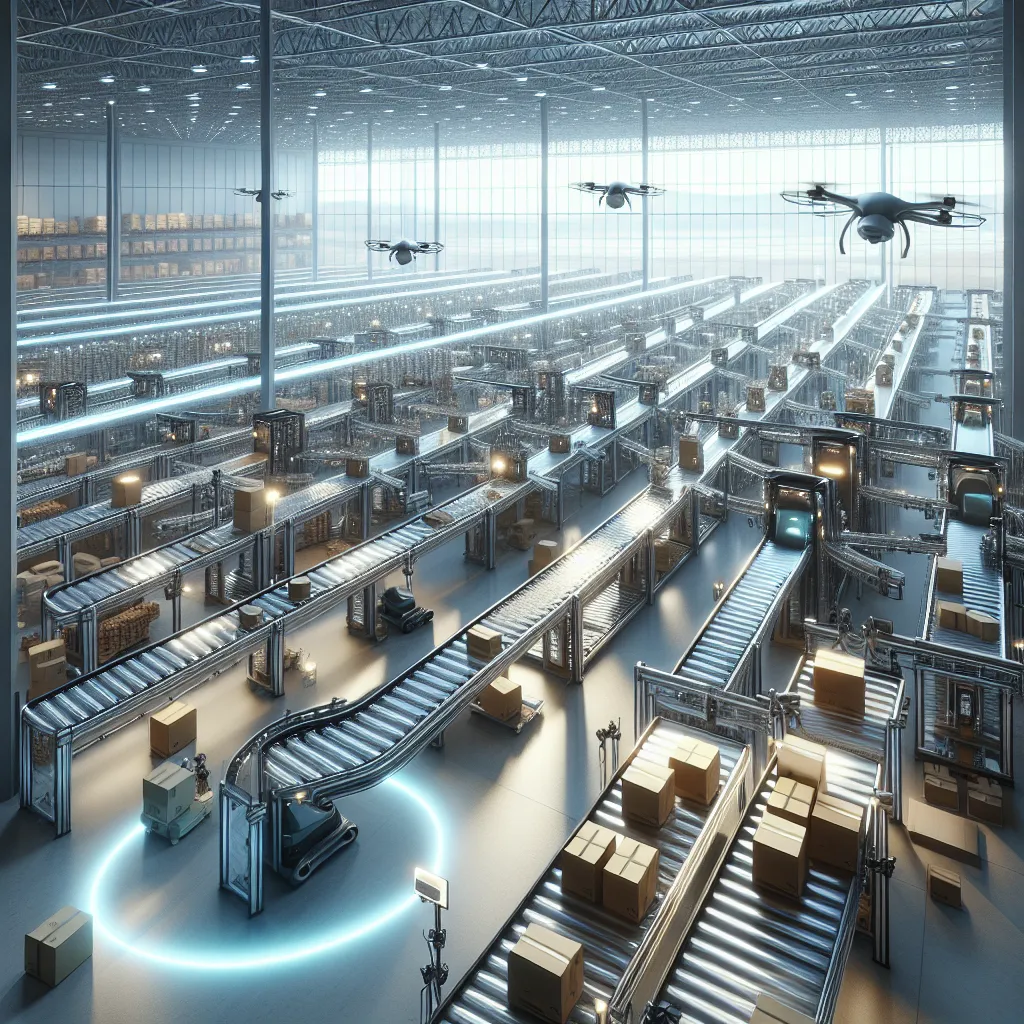As an experienced IELTS instructor, I’m excited to share with you a comprehensive IELTS Reading practice test focused on the topic of “How automation is influencing logistics and delivery systems.” This practice test will help you familiarize yourself with the IELTS Reading format and improve your skills in tackling various question types. Let’s dive into the world of automation and its impact on modern logistics!
 Automated logistics and delivery systems
Automated logistics and delivery systems
IELTS Reading Test: Automation in Logistics and Delivery
Passage 1 (Easy Text)
The Rise of Automation in Logistics
Automation has become a game-changer in the world of logistics and delivery systems. As businesses strive to meet the ever-increasing demands of consumers for faster and more efficient services, they are turning to automated solutions to streamline their operations. From warehouses to last-mile delivery, automation is revolutionizing the way goods are stored, sorted, and transported.
One of the most visible applications of automation in logistics is in warehouse management. Robotic systems are now capable of performing tasks that were once exclusively done by human workers. These robots can navigate through complex warehouse layouts, pick items from shelves, and even pack them for shipping. This not only increases efficiency but also reduces the risk of human error and workplace injuries.
Another area where automation is making significant strides is in transportation and delivery. Self-driving vehicles are being developed and tested for long-haul trucking, promising to reduce fuel consumption and increase safety on the roads. Meanwhile, drones are being explored as a potential solution for last-mile delivery, especially in remote or hard-to-reach areas.
The integration of artificial intelligence (AI) and machine learning into logistics systems is enabling companies to predict demand, optimize routes, and manage inventory with unprecedented accuracy. These technologies analyze vast amounts of data to make real-time decisions that improve efficiency and reduce costs.
However, the rise of automation in logistics is not without its challenges. There are concerns about job displacement and the need for workforce retraining. Additionally, the initial investment required for implementing automated systems can be substantial, which may be a barrier for smaller companies.
Despite these challenges, the trend towards automation in logistics and delivery systems shows no signs of slowing down. As technology continues to advance, we can expect to see even more innovative solutions that will further transform the industry, ultimately leading to faster, more reliable, and more cost-effective services for consumers and businesses alike.
Questions for Passage 1
1-5. Do the following statements agree with the information given in the passage?
Write:
TRUE if the statement agrees with the information
FALSE if the statement contradicts the information
NOT GIVEN if there is no information on this
- Automation in logistics is primarily driven by consumer demands for faster services.
- Robotic systems in warehouses can perform all tasks without any human intervention.
- Self-driving vehicles are already widely used in long-haul trucking.
- AI and machine learning help companies make more accurate predictions and decisions.
- Small companies find it easier to implement automated systems compared to larger corporations.
6-10. Complete the sentences below.
Choose NO MORE THAN TWO WORDS from the passage for each answer.
- Robotic systems in warehouses can reduce the risk of __ and workplace injuries.
- __ are being considered as a potential solution for delivering goods to remote areas.
- The integration of AI and machine learning allows companies to optimize __ with great accuracy.
- One of the concerns about automation in logistics is the potential for __ __.
- Despite challenges, automation in logistics is expected to lead to more __ services for consumers and businesses.
Passage 2 (Medium Text)
Transforming Supply Chains through Automation
The global supply chain landscape is undergoing a profound transformation, driven by the rapid advancement of automation technologies. This shift is not merely an incremental improvement but a fundamental reimagining of how goods are moved from manufacturers to consumers. As businesses grapple with increasing complexity, volatility, and customer expectations, automation emerges as a critical tool for maintaining competitiveness and resilience in the modern marketplace.
At the heart of this transformation is the concept of the “smart warehouse.” These facilities leverage a combination of robotics, Internet of Things (IoT) sensors, and artificial intelligence to create a highly efficient and responsive environment. Automated storage and retrieval systems (AS/RS) can now handle the movement of goods with minimal human intervention, significantly reducing the time and labor required for inventory management. Moreover, these systems can operate 24/7, effectively eliminating downtime and maximizing throughput.
The impact of automation extends beyond the warehouse walls. In transportation, autonomous vehicles are poised to revolutionize long-haul shipping. While fully self-driving trucks are still in development, semi-autonomous systems are already enhancing safety and efficiency on the roads. These technologies not only promise to address the persistent driver shortage but also have the potential to reduce accidents and optimize fuel consumption through platooning and predictive routing.
Perhaps one of the most exciting frontiers in automated logistics is the last-mile delivery sector. Here, innovation is taking various forms, from autonomous delivery robots navigating city sidewalks to drones capable of delivering packages to remote locations. These solutions offer the potential to dramatically reduce delivery times and costs, particularly in urban areas where traditional vehicles face congestion and parking challenges.
Central to the success of these automated systems is the role of data analytics and machine learning. By continuously analyzing vast amounts of data from across the supply chain, these technologies can predict demand patterns, identify potential disruptions, and optimize routing in real-time. This level of intelligence enables a degree of agility and responsiveness that was previously unimaginable in traditional supply chain management.
However, the transition to automated supply chains is not without its challenges. The initial capital investment required can be substantial, and there are ongoing concerns about cybersecurity and the reliability of complex automated systems. Furthermore, the workforce implications of automation are significant, necessitating a shift in skills and job roles within the logistics sector.
Despite these hurdles, the momentum behind supply chain automation shows no signs of abating. As technologies continue to mature and costs decrease, we can expect to see even greater adoption across the industry. The result will be supply chains that are not only more efficient and cost-effective but also more adaptable to the ever-changing demands of the global marketplace.
Questions for Passage 2
11-14. Choose the correct letter, A, B, C, or D.
-
According to the passage, the transformation of supply chains through automation is:
A) A minor improvement in existing systems
B) A complete overhaul of how goods are moved
C) Only affecting large corporations
D) Limited to warehouse operations -
Smart warehouses are characterized by:
A) Exclusive use of human labor
B) Limited operating hours
C) Integration of robotics, IoT, and AI
D) Focus on manual inventory management -
The potential benefits of autonomous vehicles in long-haul shipping include:
A) Eliminating the need for human drivers entirely
B) Increasing fuel consumption
C) Addressing driver shortages and improving safety
D) Slowing down delivery times -
The role of data analytics and machine learning in automated supply chains is to:
A) Replace human decision-making entirely
B) Focus solely on predicting demand patterns
C) Enhance agility and responsiveness in real-time
D) Increase the complexity of supply chain management
15-20. Complete the summary below.
Choose NO MORE THAN TWO WORDS from the passage for each answer.
Automation is transforming global supply chains, with smart warehouses at the forefront of this change. These facilities use 15__ and AI to create efficient environments. In transportation, 16__ are being developed to revolutionize long-haul shipping, while 17__ offer innovative solutions for urban deliveries. The success of these systems relies heavily on 18__, which enables unprecedented levels of optimization. However, the transition faces challenges, including high 19__ and concerns about cybersecurity. Despite these issues, automation in supply chains is expected to continue, leading to increased 20__ in meeting market demands.
Passage 3 (Hard Text)
The Socioeconomic Implications of Automated Logistics
The inexorable march of automation in logistics and delivery systems is not merely a technological revolution but a socioeconomic paradigm shift with far-reaching implications. As we stand on the cusp of this transformation, it becomes imperative to scrutinize not only the operational efficiencies gained but also the broader impact on society, labor markets, and economic structures.
At the forefront of this shift is the reconfiguration of the workforce. The traditional logistics sector has long been a significant employer, particularly for those without higher education. However, the advent of automated systems threatens to displace a substantial portion of these jobs. Warehouse workers, truck drivers, and delivery personnel find themselves at risk of obsolescence as robots, autonomous vehicles, and drones increasingly take over their roles. This displacement raises critical questions about the future of work and the need for comprehensive reskilling and upskilling programs to ensure that workers can transition to new roles within the evolving logistics landscape or find opportunities in other sectors.
Conversely, automation is also creating new job categories that didn’t exist a decade ago. The design, implementation, and maintenance of automated systems require a workforce with specialized skills in robotics, AI, and data analytics. This shift in demand is reshaping educational priorities and vocational training programs, with a growing emphasis on STEM fields and digital literacy. The challenge lies in ensuring that the creation of these high-skilled jobs can offset the loss of traditional roles, both in terms of numbers and accessibility.
From an economic perspective, the efficiency gains promised by automated logistics have the potential to significantly reduce operational costs for businesses. This could lead to lower prices for consumers and increased competitiveness in global markets. However, these benefits must be weighed against the potential for market concentration, as smaller companies without the capital to invest in automated systems may struggle to compete, potentially leading to oligopolistic tendencies in the logistics sector.
The environmental implications of automated logistics present a complex picture. On one hand, optimized routing, platooning of autonomous vehicles, and more efficient warehouse operations could substantially reduce carbon emissions associated with the movement of goods. Drone deliveries and autonomous electric vehicles for last-mile logistics offer the promise of further reducing the environmental footprint of delivery services. However, the production and disposal of automated systems, particularly the electronics and batteries they rely on, raise concerns about resource extraction and e-waste management.
Moreover, the shift towards automated logistics has profound implications for urban planning and infrastructure development. The rise of e-commerce, accelerated by efficient automated delivery systems, is changing the face of retail and consequently, the use of urban spaces. As traditional brick-and-mortar stores decline, cities may need to rethink zoning laws and repurpose commercial areas. Simultaneously, the infrastructure required to support autonomous vehicles and drone deliveries – from specialized lanes to landing pads – will necessitate significant urban redesign.
The ethical considerations surrounding automated logistics also warrant careful examination. Issues of privacy and data security come to the fore as these systems collect and analyze vast amounts of information about consumer behavior and movements. There are also questions about liability and decision-making in autonomous systems, particularly in scenarios where AI must make split-second choices that could have serious consequences.
As we navigate this transition, policy makers face the daunting task of balancing innovation with societal needs. Regulations must evolve to address the unique challenges posed by automated logistics while fostering an environment that encourages technological advancement. This may include developing new frameworks for worker protection, updating transportation laws to accommodate autonomous vehicles, and establishing guidelines for the ethical use of AI in logistics decision-making.
In conclusion, while the operational benefits of automated logistics are clear, its wider socioeconomic impact is multifaceted and complex. As we move forward, it is crucial to approach this transformation with a holistic view, considering not just the technological possibilities but also the broader implications for society, the economy, and the environment. Only through thoughtful consideration and proactive management can we ensure that the benefits of automated logistics are equitably distributed and that potential negative consequences are mitigated.
Questions for Passage 3
21-26. Complete the sentences below.
Choose NO MORE THAN THREE WORDS from the passage for each answer.
-
The automation of logistics is described as a __ __ __ that goes beyond just technological changes.
-
Traditional logistics jobs are at risk of __ due to the introduction of automated systems.
-
To address job displacement, there is a need for __ __ __ programs.
-
The efficiency gains from automated logistics could lead to __ __ for consumers.
-
Automated logistics systems have the potential to __ __ __ associated with transporting goods.
-
The rise of e-commerce and automated delivery is changing __ __ in urban areas.
27-33. Do the following statements agree with the claims of the writer in the passage?
Write:
YES if the statement agrees with the claims of the writer
NO if the statement contradicts the claims of the writer
NOT GIVEN if it is impossible to say what the writer thinks about this
-
The creation of new high-skilled jobs in automation will definitely compensate for the loss of traditional logistics roles.
-
Smaller companies may find it difficult to compete with larger firms that can invest in automated systems.
-
The environmental impact of automated logistics is entirely positive.
-
Urban planning will need to adapt to accommodate the infrastructure required for automated logistics.
-
Automated logistics systems pose no significant privacy concerns.
-
Current regulations are sufficient to address the challenges posed by automated logistics.
-
The benefits of automated logistics will automatically be distributed equally across society.
34-36. Choose the correct letter, A, B, C, or D.
-
According to the passage, the shift towards automated logistics is likely to:
A) Only affect low-skilled workers
B) Create more jobs than it eliminates
C) Require changes in educational priorities
D) Have no impact on the job market -
The environmental impact of automated logistics is described as:
A) Entirely negative
B) Completely positive
C) Complex and multifaceted
D) Insignificant in the long term -
The author suggests that policy makers need to:
A) Prevent the development of automated logistics
B) Focus solely on the economic benefits of automation
C) Balance innovation with societal needs
D) Ignore the ethical implications of automation
Answer Key
Passage 1 Answers:
- TRUE
- FALSE
- NOT GIVEN
- TRUE
- FALSE
- human error
- Drones
- routes
- job displacement
- cost-effective
Passage 2 Answers:
- B
- C
- C
- C
- robotics
- autonomous vehicles
- delivery robots
- data analytics
- initial capital investment
- adaptability
Passage 3 Answers:
- socioeconomic paradigm shift
- obsolescence
- reskilling and upskilling
- lower prices
- reduce carbon emissions
- urban spaces
- NO
- YES
- NO
- YES
- NO
- NO
- NO
- C
- C
- C
This IELTS Reading practice test on “How automation is influencing logistics and delivery systems” covers a wide range of aspects related to the topic, from the basic concepts to more complex socioeconomic implications. By working through these passages and questions, you’ll not only improve your reading comprehension skills but also gain valuable insights into this rapidly evolving field.
Remember to practice time management as you would in the actual IELTS test. Pay close attention to the keywords in both the passages and questions, and always refer back to the text to verify your answers. If you’re interested in exploring related topics, you might want to check out our article on how automation is changing global supply chains for a broader perspective on the impact of automation in various industries.
Good luck with your IELTS preparation, and remember that consistent practice is key to achieving your desired score!


